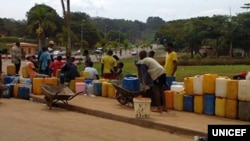World Water Day will be observed on March 22 but by far not every country enjoys easy access to the commodity. Among them is Cameroon where residents of major cities suffer frequent water cuts, with schools impacted in particular.
During a noisy morning at the Grace nursery and primary school in the Damas neighborhood in Cameroon's capital city, Yaounde, children all carry water bottles in their bags.
Jannette Nanyongo, the school’s head teacher says at times the neighborhood in which their school is located goes for a month without a pipe-borne water supply.
"Children come late because they have to go a distance to look for water. We pity the situation and we cannot punish a child for coming late because he went to carry water. We are in need of water. We sensitize [i.e. educate] our [students’] parents. They make the children come to school with their water containers. The water that we have to keep for them in school is not all that sufficient," Nanyongo said.
At a stream situated at Tam Tam Week End, three kilometers from the Damas neighborhood, hundreds of people are assembling to fetch water. Animals are drinking from the same source and families are also washing their clothes there.
Among the people there was Fabian Tantoh who said he would filter the water before drinking it.
"I am telling you that it is two weeks today in Tam Tam Week End that there is no [pipe-borne] water supply. We capture water from the rain and then we filter it before [we] drink it. There are even people that take water from the streams to drink directly without having a filter because the filter is not given to everybody. So you must drink water the way that you have seen it. You drink it," Tantoh said.
Those who have the means get bottled water.
Yaounde has a population of over three million. Residents need a daily supply of about 300,000 cubic meters of pipe-borne water but barely 35 percent of it is supplied. People have resorted to unsafe sources to get the precious liquid.
Others rely on rainfall, but dry seasons are now longer and rainy seasons shorter than they were 30 years ago. Augustine Njamshi of the environmental non-governmental organization Bio-Resource and Development Center in Cameroon says constant changes in weather patterns are impacting water supply.
"We have the issue of climate change which is making rainwater harvesting very, very difficult for communities that have been depending on rainwater harvesting to have their source of fresh water for use. So it is a big concern and we think that this has to be redressed as soon as possible. We are endowed with fresh water resources, but we do not have water to drink," Njamshi said
Cameroon plans to increase Yaounde’s water supply to 500,000 cubic meters in two years by tapping into the Sanaga, one of the country's largest rivers.The move should increase potable water supply from more than 30 percent to 60 percent of the population.
Cameroon is not alone in this. U.N.-Water, which coordinates the annual World Water Day campaign, reports that there are over 663 million people in the world living without a safe water supply close to home, spending countless hours queueing for or trekking to distant sources, and coping with the health impacts that come with using contaminated water.





